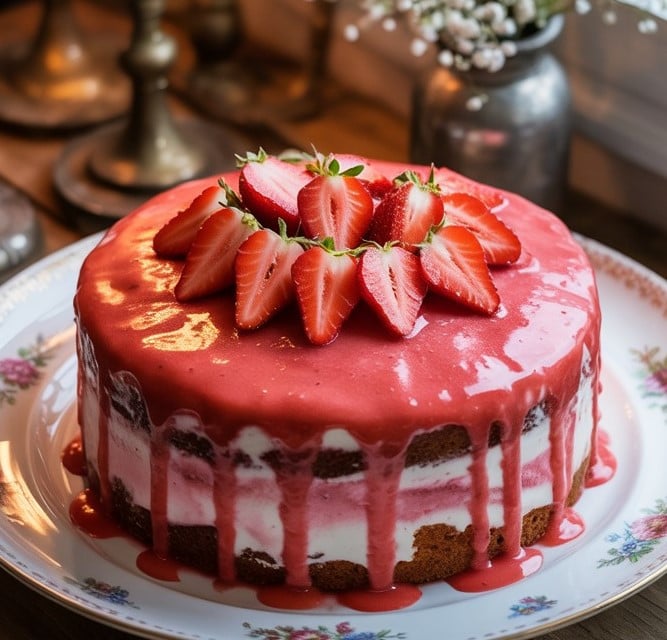The week my herb garden got taken over by mint, I accidentally rediscovered my love for lemons. I was making iced tea to use up the mint, and thought a splash of lemon would brighten things up. That’s when I spotted a nearly forgotten bag of lemons at the back of the fridge, and the scent hit me like a breeze through a sunlit kitchen window.
It brought a kind of freshness I hadn’t cooked with in a while—bold, fragrant, nostalgic but energizing. So instead of just lemonade or lemon bars, I went for something that felt like it had roots—something warm, soft, and rich: a Lemon Buttermilk Pound Cake.
I’d been meaning to tweak my usual pound cake for ages. This time, the buttermilk softened the crumb beautifully, and the lemon zest added a brightness that made each bite feel like a gentle nudge toward spring—even if it was pouring outside.
I topped it with a simple glaze that clung to the ridges of the bundt like a finishing touch on a well-loved heirloom. That day, I served slices on floral plates, dusted with extra zest, and even my neighbor—who claims not to like dessert—asked for the recipe. And here it is.

Short Description
A rich, moist pound cake with a bright lemony flavor and a tender crumb, thanks to creamy buttermilk and fresh citrus. Finished with a simple glaze for a perfectly tangy-sweet bite.
Key Ingredients
For the Cake:
- 1 cup unsalted butter, softened
- 2½ cups granulated sugar
- 4 large eggs, room temperature
- 1 tablespoon lemon zest
- 2 tablespoons fresh lemon juice
- 1 teaspoon vanilla extract
- 3 cups all-purpose flour
- ½ teaspoon baking soda
- ½ teaspoon salt
- 1 cup buttermilk
For the Lemon Glaze:
- 1½ cups powdered sugar
- 2–3 tablespoons fresh lemon juice
- 1 teaspoon lemon zest (optional, for garnish)
Tools Needed
- 10-inch bundt or tube pan
- Electric mixer or stand mixer
- Mixing bowls
- Rubber spatula
- Whisk
- Cooling rack
Cooking Instructions
Step 1: Preheat the Oven
Preheat oven to 325°F (163°C). Grease and flour a 10-inch bundt or tube pan thoroughly to prevent sticking.
Step 2: Cream Butter and Sugar
In a large mixing bowl, beat the softened butter and granulated sugar on medium speed for 4–5 minutes, until the mixture becomes light and fluffy.
Step 3: Add Eggs and Flavorings
Beat in the eggs one at a time, making sure each one is fully incorporated before adding the next. Mix in the lemon zest, lemon juice, and vanilla extract.
Step 4: Combine Dry Ingredients
In a separate bowl, whisk together flour, baking soda, and salt.
Step 5: Add Dry Ingredients and Buttermilk Alternately
Add the flour mixture to the wet ingredients in three additions, alternating with the buttermilk. Begin and end with the flour mixture. Mix just until combined to avoid overworking the batter.
Step 6: Bake the Cake
Pour the batter into the prepared pan and smooth the top with a spatula. Bake for 60–70 minutes, or until a toothpick inserted into the center comes out clean.
Step 7: Cool the Cake
Let the cake rest in the pan for 15 minutes, then carefully invert it onto a wire rack. Allow it to cool completely before glazing.
Step 8: Prepare the Lemon Glaze
In a bowl, whisk together powdered sugar and lemon juice until smooth and pourable. If it’s too thick, add a bit more lemon juice. If it’s too thin, add a little more powdered sugar.
Step 9: Glaze the Cake
Drizzle the glaze over the completely cooled cake, letting it drip down the sides naturally. Garnish with extra lemon zest if desired.
Why You’ll Love This Recipe
– Moist and tender texture from buttermilk
– Easy enough for beginners, elegant enough for gatherings
– No special ingredients—just pantry basics
– Not too sweet—balanced with citrusy brightness
Mistakes to Avoid & Solutions
1. Overmixing the batter
Overmixing can make the cake dense and tough. Once the flour is added, mix only until combined.
2. Not greasing the pan properly
Pound cakes are notorious for sticking. Use butter and flour or a baking spray with flour included. Pay attention to every curve of the bundt pan.
3. Using cold ingredients
Room temperature butter, eggs, and buttermilk blend more evenly and create better texture.
4. Overbaking
Start checking at 60 minutes. Insert a toothpick—if it comes out with a few moist crumbs, it’s ready.
5. Pouring glaze on a warm cake
If the cake is too warm, the glaze melts into it. Wait until it’s fully cooled to get that pretty, drippy effect.
Serving and Pairing Suggestions
Serve thick slices with a cup of black tea, herbal infusion, or iced green tea. Add a dollop of whipped cream and fresh berries for a brunch-worthy dessert.
It also pairs beautifully with lemon sorbet or a drizzle of blueberry compote. Works well as part of a dessert table, plated individually, or even wrapped in wax paper for picnic-style gatherings.
Storage and Reheating Tips
Store at room temperature in an airtight container for up to 3 days.
Refrigerate for up to 1 week, wrapped tightly in plastic wrap.
Freeze individual slices for up to 2 months. Wrap in plastic, then foil, and store in a freezer-safe bag.
Reheat by bringing to room temperature or warming in the microwave for 10–15 seconds. Glaze may slightly melt but flavor remains intact.
FAQs
1. Can I use bottled lemon juice instead of fresh?
Fresh lemon juice is best for a bright, natural flavor, but bottled can work in a pinch. Reduce the amount slightly, as it’s often more acidic.
2. Can I make this cake gluten-free?
Yes, use a 1:1 gluten-free flour blend. Make sure it includes xanthan gum for structure.
3. What can I use if I don’t have buttermilk?
Stir 1 tablespoon lemon juice or vinegar into 1 cup milk. Let sit for 5 minutes before using as a substitute.
4. How do I prevent my bundt cake from sticking?
Grease every curve of the pan well with butter and flour or baking spray with flour. Don’t rush this step.
5. Can I make this into cupcakes or a loaf cake?
Yes! Divide the batter into cupcake tins (bake 20–25 minutes) or two loaf pans (bake 45–55 minutes). Adjust time and check for doneness.
Tips & Tricks
– For extra lemon flavor, add a teaspoon of lemon extract to the batter.
– Use a microplane to zest lemons easily and finely.
– If your powdered sugar is clumpy, sift it before making the glaze.
– Don’t open the oven door during the first 50 minutes—it can make the cake collapse.
– Let the cake sit overnight—it tastes even better the next day as the lemon settles in.
Recipe Variations
Lemon Poppy Seed Pound Cake
Add 2 tablespoons of poppy seeds to the batter with the flour mixture. The seeds give a pleasant crunch and visual appeal.
Lemon-Blueberry Pound Cake
Fold in 1½ cups fresh blueberries tossed in 1 tablespoon flour before pouring the batter into the pan. The berries burst and add juiciness.
Coconut Lemon Pound Cake
Swap ½ cup of the flour with shredded sweetened coconut, and top the glaze with toasted coconut flakes. Adds a tropical flair.
Honey-Lemon Pound Cake
Replace ½ cup of sugar with ⅓ cup of honey and reduce buttermilk slightly. The honey adds floral sweetness and deeper notes.
Gluten-Free Almond Lemon Cake
Use gluten-free flour and replace ½ cup of the flour with almond flour. Add a touch of almond extract in place of vanilla.
Final Thoughts
Lemon Buttermilk Pound Cake has a way of stealing the spotlight without asking for it. It’s humble enough to share a table with coffee or tea, yet rich enough to serve at any celebration. What makes it memorable isn’t just the citrus or the glaze, but the way it brings a certain lightness into the room—on the palate and in the air.
The buttermilk gives it a softness that lingers just long enough. It’s not flashy, just honest. A cake that reminds you that simple flavors, when done right, can feel like a small gift. It’s now one of those recipes I reach for when I want to share something genuine—sunny, warm, and just sweet enough.

Lemon Buttermilk Pound Cake
Ingredients
For the Cake:
- 1 cup unsalted butter softened
- 2½ cups granulated sugar
- 4 large eggs room temperature
- 1 tablespoon lemon zest
- 2 tablespoons fresh lemon juice
- 1 teaspoon vanilla extract
- 3 cups all-purpose flour
- ½ teaspoon baking soda
- ½ teaspoon salt
- 1 cup buttermilk
For the Lemon Glaze:
- 1½ cups powdered sugar
- 2 –3 tablespoons fresh lemon juice
- 1 teaspoon lemon zest optional, for garnish
Instructions
- Preheat the oven: Set oven to 325°F (163°C). Grease and flour a 10-inch bundt or tube pan well so the cake doesn’t stick.
- Cream the butter and sugar: In a large bowl, beat softened butter and sugar on medium speed for 4–5 minutes, until light and fluffy.
- Add eggs and flavorings: Beat in eggs one at a time. Stir in lemon zest, lemon juice, and vanilla extract.
- Mix dry ingredients: In another bowl, whisk together flour, baking soda, and salt.
- Combine wet and dry: Add flour mixture in three parts, alternating with buttermilk. Start and end with flour. Mix just until blended.
- Bake the cake: Pour batter into the prepared pan and smooth the top. Bake for 60–70 minutes, or until a toothpick comes out clean.
- Cool the cake: Let it rest in the pan for 15 minutes, then carefully turn it out onto a wire rack. Cool completely before glazing.
- Make the lemon glaze: Whisk powdered sugar with lemon juice until smooth and pourable. Adjust consistency with more sugar or juice as needed.
- Glaze the cake: Drizzle glaze over the cooled cake. Let it drip down the sides. Sprinkle extra lemon zest on top, if desired.



